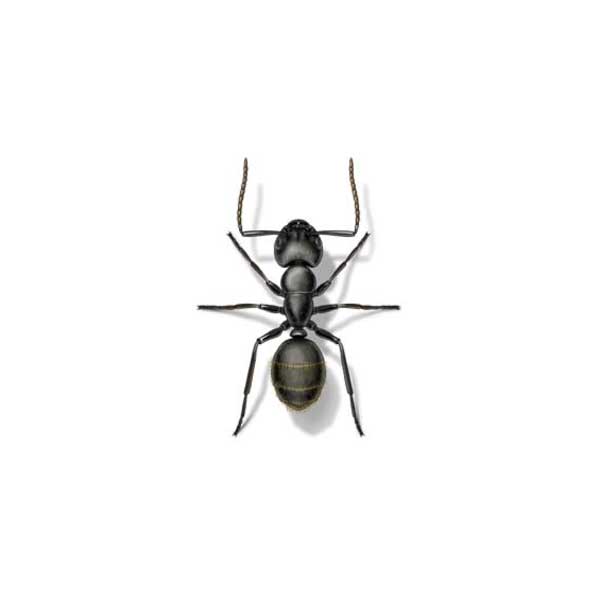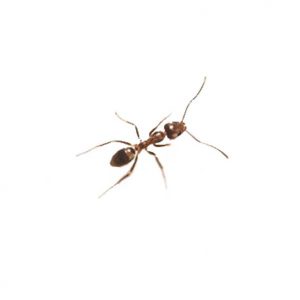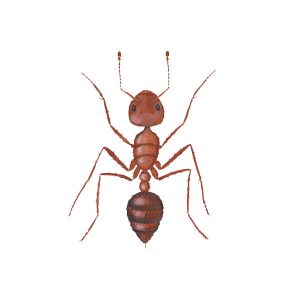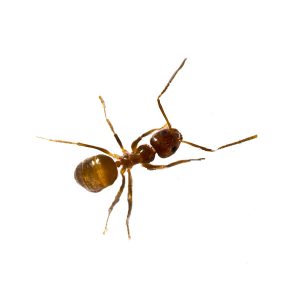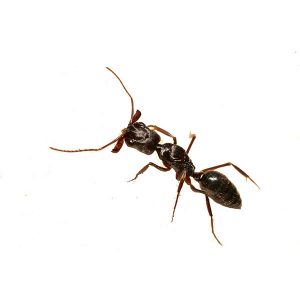Carpenter Ants in Georgia
Carpenter ants (Camponotus spp.) are wood-destroying insects that can cause significant damage to homes and buildings. Often confused with termites, these ants tunnel through wood to create nesting sites, weakening the structure over time. Carpenter ants in Georgia thrive in both urban and rural environments. They are particularly attracted to areas with moisture problems, making them a common pest in homes with leaks or decaying wood. If left unchecked, a carpenter ant infestation can lead to structural damage, such as collapsed walls or weakened support beams.
H3: What Do Carpenter Ants Look Like?
Carpenter ants are typically large, ranging in size from 1/4 inch to 5/8 inch long. They have smooth, shiny bodies with a distinct constriction between their thorax and abdomen, which can help with carpenter ant identification. Carpenter ant bodies are segmented, and you can often spot their presence when they leave behind sawdust or wood shavings near their nesting sites. Winged males and female carpenter ant swarmers can also be found during mating season, typically in the spring or early summer.
Georgia has two main species: the black carpenter ant (Camponotus pennsylvanicus) and the Florida carpenter ant (Camponotus floridanus). As their name suggests, the black carpenter ants are mainly black in color, with yellowish hairs on their abdomen, although some may be reddish or a combination of black and red. Florida carpenter ants differ in that they have a reddish-colored head and thorax and a shiny black abdomen.
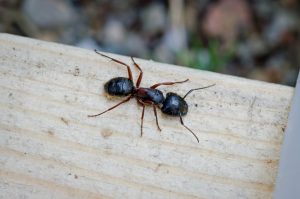 Black carpenter ant (Camponotus pennsylvanicus)
Black carpenter ant (Camponotus pennsylvanicus)
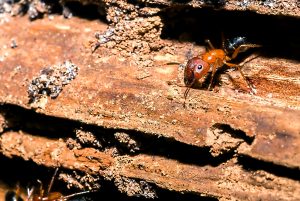 Florida carpenter ant (Camponotus floridanus)
Florida carpenter ant (Camponotus floridanus)
Signs of a Carpenter Ant Infestation
The most common sign of a carpenter ant infestation is the presence of wood shavings or sawdust near walls, windows, or floors. These tiny particles are the byproducts of the ants’ excavation activities as they tunnel through wood. Other signs include a crinkling sound or faint rustling noises in walls or hollow spaces, which could be from worker ants foraging for food, and sightings of winged ants inside your home could indicate the presence of a satellite nest or an active carpenter ant colony. Additionally, carpenter ants may leave trail marks on walls or floors as they move between nests.
Habitat, Diet, Life Cycle & Behaviors
Where Do Carpenter Ants Live?
Outdoors carpenter ants prefer damp wood, making decaying trees, fallen branches, or damp firewood the perfect spots for their nests. Decayed wood provides an ideal environment for carpenter ant colonies, and they are often found in areas with moisture problems: around tree stumps, rotting fence posts, and wooden structures.
Indoors, carpenter ants infest wooden structures, such as wall voids, foam insulation, and hollow doors. Nest sites can be found in wooden structures that have suffered from water damage or excessive moisture.
Carpenter ants often enter homes through cracks in foundations or via plumbing and electrical openings. Once inside, they can establish nests in hidden areas, such as wall voids and cavities in ceilings. Over time, satellite nests may form, and the colony will expand, making it harder to control the infestation without professional pest control services.
Diet
Carpenter ants are omnivorous and will eat a wide variety of food, including sugary substances like honeydew produced by aphids and proteins and fats. Foraging for food typically takes place at night, with worker ants leaving the nest to search for food sources. Carpenter ants may feed on meat, cheese, fruits, and sugary liquids. Because of their love for honeydew, you may also find them around areas with aphid infestations.
Life Cycle
Carpenter ants go through a complete metamorphosis, which includes the egg, larva, pupa, and adult stages. Their larvae hatch from eggs laid by the carpenter ant queen, and the workers care for the larvae by feeding them and keeping them safe in the colony. The first brood of ants develops into workers, who go on to forage and build new nests. Once the colony matures, the queen will produce winged males and females, known as carpenter ant swarmers, which will leave the parent nest to mate and establish new colonies. This process typically happens in late spring to early summer.
Behaviours
Carpenter ants are nocturnal and primarily forage for food at night. They are social insects that live in large colonies, often with a single queen. The workers in the colony take on various roles, from excavating wood to caring for the larvae and searching for food. While carpenter ants are not aggressive, they can become a problem when their nests expand within the walls of homes.
If disturbed, carpenter ants may bite, and while they rarely sting, they have an effective defense mechanism: they can spray formic acid. This acid, produced in their venom gland, is often used to ward off predators or competitors. Though not harmful to humans, the acid can enhance the pain of a bite if sprayed into the wound.
Are Carpenter Ants Dangerous?
Carpenter ants are not dangerous in the sense of causing harm to people, as they rarely bite and do not sting like other insects. However, they pose a significant threat to homes and buildings due to their ability to weaken the structural integrity of wooden structures. By excavating tunnels and galleries through wood, carpenter ants can cause extensive damage over time, leading to costly repairs.
While a single carpenter ant colony may initially seem manageable, their populations can grow rapidly, forming satellite nests branching out from the original colony. These additional nests can multiply the damage and make infestations harder to control. Unlike termites, carpenter ants do not eat wood but can still create widespread destruction by hollowing out wooden structures, such as wall voids and support beams.
In summary, while carpenter ants are not physically dangerous to humans, their ability to compromise the structure of your home makes them a serious pest that demands prompt attention from an experienced ant exterminator.
How to Get Rid of Carpenter Ants?
Dealing with a carpenter ant infestation requires a multi-step approach. First, it’s crucial to identify the carpenter ant nest and understand the extent of the damage. Exterminators typically begin by locating the nest and determining if there are any moisture issues in the affected area. Treatment methods include using insecticides, baits, and the physical removal of the nest. Carpenter ant colonies can be difficult to eliminate without professional pest control, as they often hide in hard-to-reach areas like wall voids or hollow doors.
In some cases, it may also be necessary to repair the damage caused by the infestation, especially if structural integrity has been compromised. Preventative treatments, such as sealing cracks in foundations and addressing moisture issues, can help reduce the risk of future infestations.
Carpenter Ant Prevention Tips
Preventing carpenter ant infestations begins with eliminating the conditions that attract them. Address any moisture problems in your home by fixing leaks and ensuring proper ventilation in damp areas, such as basements and attics. Regularly inspect wooden structures for signs of decay or damage, and seal any cracks in the foundation or walls to prevent ants from entering. Storing firewood away from the home and keeping trees trimmed can also help minimize the risk of an infestation.
Do You Have an Ant Infestation Problem? We Can Help!
If you suspect a carpenter ant infestation or notice any of the signs mentioned earlier, it’s important to take immediate action. An experienced pest control professional from Active Pest Control can inspect your property and implement effective treatments to eliminate carpenter ants before they cause significant damage.
Dealing with an ant infestation can be challenging, especially when different ant species, such as carpenter ants, acrobat ants, fire ants, or tawny crazy ants, are involved. Each type of ant has unique behaviors and risks, and we can advise you on how best to protect your property and remove an existing infestation.
Don’t let ants take over your home. Contact Active Pest Control today for a thorough inspection and reliable pest control solutions.
Frequently Asked Questions
Do carpenter ants bite?
Yes, carpenter ants can bite if they feel threatened, but their bites are not dangerous. They do not typically sting like other pests.
Do carpenter ants have wings?
Yes, during the swarming season, carpenter ants develop wings. These winged males and females, also known as swarmers, leave the nest to mate and form new colonies.
Do carpenter ants eat wood?
No, carpenter ants do not eat wood like termites. They excavate wood to build their nests but do not consume it for sustenance.
How can you find a carpenter ant nest?
Look for signs such as wood shavings, sawdust, or crinkling sounds from inside walls. Carpenter ants often nest in wall voids or decaying wood.
Need help with pest control?
Fill out the form below and we’ll be in touch!
*During normal business hours. After hours inquiries will be returned the next business day.

